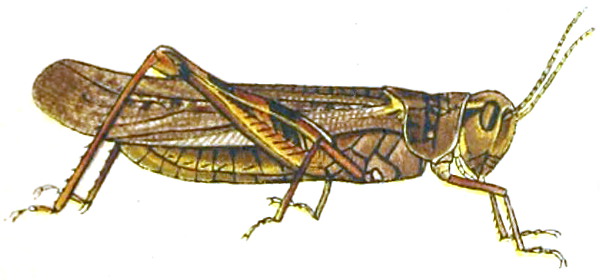
In the 1870s, new farmsteads on the American plains were beset by enormous swarms of grasshoppers sweeping eastward from the Rocky Mountains. The insects were a disaster for vulnerable farmers, attacking in enormous numbers and devouring everything before them. In this week’s episode of the Futility Closet podcast we’ll describe the grasshopper plagues and the settlers’ struggles against them.
We’ll also delve into urban legends and puzzle over some vanishing children.
Intro:
In 2001, a Washington earthquake drew a rose with a pendulum.
In 2003, Japanese web designer Nobuyuki Kayahara created a curiously ambiguous animation.
Sources for our feature on the grasshopper plagues:
Jeffrey A. Lockwood, Locust: The Devastating Rise and Mysterious Disappearance of the Insect That Shaped the American Frontier, 2009.
Annette Atkins, Harvest of Grief: Grasshopper Plagues and Public Assistance in Minnesota, 1873-78, 2003.
Joanna Stratton, Pioneer Women, 2013.
Samuel Clay Bassett, Buffalo County, Nebraska, and Its People, 1916.
Harold E. Briggs, “Grasshopper Plagues and Early Dakota Agriculture, 1864-1876,” Agricultural History 8:2 (April 1934), 51-63.
Stephen Gross, “The Grasshopper Shrine at Cold Spring, Minnesota: Religion and Market Capitalism Among German-American Catholics,” Catholic Historical Review 92:2 (April 2006), 215-243.
Mary K. Fredericksen, “The Grasshopper Wars,” The Palimpsest 62:5 (1981), 150-161.
Cyrus C. Carpenter, “The Grasshopper Invasion,” Annals of Iowa 4:6 (July 1900), 437-447.
Chuck Lyons, “The Year of the Locust,” Wild West 24:6 (April 2012), 44-49.
Wiley Britton, “The Grasshopper Plague of 1866 in Kansas,” Scientific Monthly 25:6 (December 1927), 540-545.
G. Prosper Zaleski, “The Grasshopper Plague,” Scientific American 33:9 (Aug. 28, 1875), 132.
Thomas Hayden, “A Long-Ago Plague of Locusts,” U.S. News & World Report 136:19 (May 31, 2004), 66.
Kathie Bell, “The Grasshopper Plague,” Dodge City Daily Globe, April 15, 2019.
Lance Nixon, “Dakota Life: The Grasshopper and the Plow,” [Topeka, Kan.] Capital Journal, Sept. 3, 2015.
Frank Lee, “Grasshopper Chapel Inspires Faith, Prayer,” St. Cloud [Minn.] Times, Aug. 6, 2005, C.1.
“The Grasshopper Plague,” New York Times, July 1, 1888.
“The Grasshopper Plague,” New York Times, Dec. 29, 1876.
“The Bright Side of the Grasshopper Plague,” New York Times, July 17, 1875.
“The Grasshopper Plague,” New York Times, Aug. 10, 1874.
“The Locusts of the West,” New York Times, July 14, 1874.
“The Grasshopper Plague,” New York Times, July 14, 1874.
“The Grasshopper Plague,” New York Times, July 10, 1874.
“The Grasshoppers,” New York Times, July 10, 1874.
“A Plague of Grasshoppers,” New York Times, June 22, 1874.
Matthew Garcia, “Melanoplus spretus: Rocky Mountain Locust,” Animal Diversity Web (accessed Feb. 22, 2020).
R.L. Cartwright, “Grasshopper Plagues, 1873–1877,” MNopedia, Nov. 17, 2011.
Listener mail:
“If you thinking about taking a NIGHT TRAIN in ITALY DON’T,” Lonely Planet (accessed Feb. 14, 2020).
“Urgently Need Advice About Trenitalia Sleeper Trains,” Tripadvisor (accessed Feb. 14, 2020).
Wikipedia, “Rick Steves” (accessed Feb. 14, 2020).
“About Rick Steves,” Rick Steves’ Europe (accessed Feb. 14, 2020).
“Sleeping on Trains,” Rick Steves’ Europe (accessed Feb. 14, 2020).
John Hooper, “‘Sleeping Gas’ Thieves Target Super-Rich at Italian Billionaires’ Resort,” Guardian, Aug. 30, 2011.
Wikipedia, “Jan Harold Brunvand” (accessed Feb. 14, 2020).
Wikipedia, “Urban Legend” (accessed Feb. 14, 2020).
Jan Harold Brunvand, The Vanishing Hitchhiker: American Urban Legends and Their Meanings, 2003.
Andrew Noymer, “The Transmission and Persistence of ‘Urban Legends’: Sociological Application of Age-Structured Epidemic Models,” Journal of Mathematical Sociology 25:3 (2001), 299-323.
Henry B. Dunn and Charlotte A. Allen, “Rumors, Urban Legends and Internet Hoaxes,” Proceedings of the Annual Meeting of the Association of Collegiate Marketing Educators, 2005.
Centers for Disease Control and Prevention, “Carbon Monoxide Poisoning: Frequently Asked Questions,” March 21, 2018.
Mayo Clinic, “Carbon Monoxide Poisoning,” Oct. 16, 2019.
This week’s lateral thinking puzzle was contributed by listener Moxie LaBouche, who sent this corroborating link (warning — this spoils the puzzle).
You can listen using the player above, download this episode directly, or subscribe on Google Podcasts, on Apple Podcasts, or via the RSS feed at https://futilitycloset.libsyn.com/rss.
Please consider becoming a patron of Futility Closet — you can choose the amount you want to pledge, and we’ve set up some rewards to help thank you for your support. You can also make a one-time donation on the Support Us page of the Futility Closet website.
Many thanks to Doug Ross for the music in this episode.
If you have any questions or comments you can reach us at podcast@futilitycloset.com. Thanks for listening!
